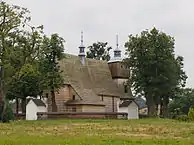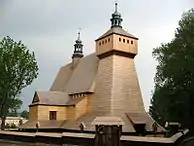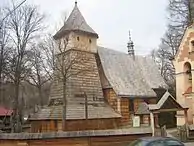_3.JPG.webp) Polish Uplanders from Bukowsko, Bukowianie, a local Polish folk music group | |
| Total population | |
|---|---|
| 700 000 (est.) | |
| Regions with significant populations | |
| 500,000 | |
| 200,000 | |
| Languages | |
| Polish | |
| Religion | |
| Predominantly Roman Catholic, with Protestant minorities | |
| Related ethnic groups | |
| Gorals and other Poles, Rusyns | |
Polish Uplanders (Polish: Pogórzanie; also known as Western Pogorzans and Eastern Pogorzans), form a distinctive subethnic group of Poles that mostly live in the Central Beskidian Range of the Subcarpathian highlands.[1] The Polish Uplanders inhabit the central and the southern half of the Beskids in Poland, including the Ciężkowickie, Strzyżowskie and Dynowskie Plateau as well as Doły Jasielsko-Sanockie, from the White River (Biała) in the west to the San River in the east.
They represent the major population group inhabiting the Subcarpathian Voivodeship, living alongside German[2][3] and Rusyn people. Historically, this region formed part of Galicia.
Polish Uplanders are neighbours with: the Lachy sądeckie to the west; Krakowiacy and Rzeszowiacy to the north; and Dolinians (vale-dwellers) and Lemkos (both Rusyn subgroups) to the south.
Cultural subdivisions of the Uplanders distinguish the western Uplanders (the area of Gorlice, Jasło and Strzyżów) from the eastern Uplanders (Sanok and Brzozów). The border between those two groups lies in the region of Krosno. The differences between western and eastern groups were especially seen in architecture and in clothing.
Traditional occupations of the Polish Uplanders included agriculture, oil-mining and the military; today these are joined by the service and petroleum industries, and by agrotourism. Polish scholars regard the Pogórzan dialect as part of the Lesser Polish dialect cluster.
Eastern Pogorzan landscape
| Blizne, Subcarpathia (Red Ruthenia) (c. 1450) |
Haczów, Subcarpathia (Red Ruthenia) (1388) c. 1624 |
Binarowa, Subcarpathia (1400) c. 1500 |
|---|---|---|
 |  |  |
History
In 1854 in the village Bóbrka near Krosno, the first oil field in the world began production.[4]
Foods
See also
References
- ↑ Na początku lat sześćdziesiątych XX wieku nazewnictwo to zakwestionował Franciszek Kotula. [in:] Polskie stroje ludowe. cz. 3. 2007
- ↑ Taubdeutsche
- ↑ Eastern Pogorzans - Bachórz (Großbachersdorf), Besko, Białobrzegi (Palversee), Brzozów (Bresen), Bukowsko, Bonarówka (Bonnersdorf), Domaradz (Deutsch-Domaretz), Dynów (Dühnhof, Denow), Frysztak (Freistadt), Głowienka, Haczów (Hanshof), Harta (Harth), Dylągówka (Dillingshau), Iskrzynia, Iwonicz (Iwanitz), Jaćmierz (Jatschmirs), Jasło (Jessel), Jaśliska (Hohenstadt), Jurowce, Klimkówka, Kombornia (Kaltborn), Korczyna (Kotkenhau), Krośnie (Krossen), Królik Polski (Johannsdorf), Lalin Niemiecki, Lubatówka (Bischofswald), Łęzany, Matysówka (Mathisowka), Michałowce (Michelsdorf), Miejsce Piastowe (Peistätten), Mrzygłód (Königlich Thirau), Nowotaniec (Lobetans), Niebieszczany(Siebenwirt), Nowy Żmigród (Schmiedeburg), Odrzykoń (Ehrenberg), Pielnia (Pellen), Poraż (Kunzendorf), Prusiek(Prosegg), Rogi, Równe, Rymanów, (Reimannshau) Rytarowce (Rittersdorf), Sanok, Strachocina, Strzyżów, Suchodól (Diernthal), Szufnarowa (Schaffnerhau) Targowiska, Trepcza, Tułkowice (Tillkersdorf) Trześniów, Tyrawa (Salzthirau), Tyczyn (Bertoldsdorf), Wielopole (Großenfeld), Wrocenka, Wojnarówka, Wiśniowa, Zarszyn (Sarschin) Zmennica, Zymbertowa (Siebenwirth)
- ↑ The Ignacy Łukasiewicz Memorial Museum of Oil Industry. Andrzej Kozłowski, Uniwersytet Warszawski. Oil field in Bóbrka. Official website.
Bibliography
- Michael Burleigh. Germany Turns Eastwards. Astudy of Ostforschung in the Third Reich. Cambridge. 1988.
- Ernst Schwarz. Von den "Walddeutschen" in Galizien, "Schlesien" Jh. V. Z. III. S. 147–156.
- Wojciech Blajer. Bemerkungen zum Stand der Forschungen uber die Enklawen der mittelalterlichen deutschen Besiedlung zwischen Wisłoka und San. [in:] Późne średniowiecze w Karpatach polskich. red. Prof. Jan Gancarski. Krosno. 2007. ISBN 978-83-60545-57-7
External links
- Pogorzans (Polish Uplanders)
- Pogórzanie
- Gisele Hildebrandt, Otto Adamski. Dorfimfersuchungen in dem alten deutsch-ukrainischen Grenzbereich von Landshuf. Kraków. 1943. Urzejowice, (Urzejowice) Markowa (Markowa)